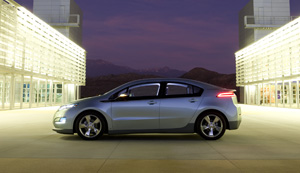
PARIS – General Motors Co.’ decision in 2004 to swap the Chevrolet brand for the Daewoo marque in many world markets is paying off in Europe, where Chevy is growing faster than competitive entry-level brands such as Hyundai, Kia and Skoda.
Just as the economic crisis turned Western Europe’s market toward low-cost, Chevrolet was there to take advantage.
Thanks to sales outside North America, Chevrolet says it remained the fourth best-selling global brand in 2009, with 3.5 million units. Of these, 425,874 were delivered in Europe, including Russia and Uzbekistan, the brand’s sixth and seventh largest markets after the U.S., Brazil, China, Canada and Mexico.
Chevrolet is pleased it was able to double sales in Europe from 2005 to 2008 with products inherited from the former Daewoo Motors Co. Ltd in Korea when GM bought most of the company.
Now that the lineup is being replaced with vehicles engineered by GM, the brand expects to double sales again to reach 1 million units annually by 2015, Chevrolet Europe President Wayne Brannon says.
Chevrolet was able to hold its own in Europe last year, despite suffering massive losses in Russia and Uzbekistan, both crippled by the global financial meltdown. Total 2009 deliveries fell 14% to 426,000, including a 57% decline in Russia offset by a 15% increase in Western Europe, where scrapping incentives encouraged sales of small cars.
Critics were numerous when GM announced plans to make Chevrolet a global brand, says Brannon, here to celebrate the division’s 132% sales spike in France last year.
“Chevrolet has been a conglomerate of vehicles from many sources,” he says at the event, with Chevy-badged models from North America sold in the Middle East, Opel cars sold as Chevrolets in South America along with pickups made by Isuzu Motors Ltd.
However, Chevrolet’s range now is starting to be the same around the world, with vehicles developed at GM engineering centers in Detroit, Russelsheim, Seoul, Sao Paolo and Geelong, Australia. A united portfolio will help raise awareness of the brand in newer markets for the brand such as Western Europe, Brannon says.

Chevrolet displayed the Volt, Cruze, Spark and Aveo replacement at the North American International Auto Show in January, all of which will be joining its regional lineup in the coming years.
The Cruze compact car and B-segment Spark already are on sale in Europe. The extended-range Volt hybrid is coming in 2011, as is the Camaro coupe and convertible. Europe also will get the new Aveo. The Orlando, a Cruze-based people mover, will coin the range in both America and Europe.
At the Geneva auto show in March, Chevrolet will display the Cruze, Spark, Captiva, Camaro, Volt, Aveo RS concept from Detroit and the Orlando concept from the 2008 Paris auto show. Plus perhaps an eighth vehicle, Brannon says.
In addition, he would like to sell the Corvette in Europe. Brannon says GM is considering the move and indicates the decision is linked to whether to Cadillac will be re-launched here.
Dutch distributor Kroymans Corp. had been selling both for five years but quit at the end of 2009. Sales never reached expectations, even before the economic crisis hit.
The relationship between Chevrolet and Adam Opel GmbH in Europe is not strained, says Brannon, although Opel sales according to the ACEA manufacturers’ association were down 7.8% in West Europe last year, compared with Chevrolet, up 5.5%.
However, company research indicates Chevy customers hardly ever have Opel on their short list.
“The movement of our (market) shares is unrelated,” Brannon says. “We have 1,100 dealerships that sell Opel and Chevrolet. Our data tell us there is almost zero connection between our brands. Skoda, SEAT, Hyundai and Kia have more interaction with Opel than Chevrolet.”
The increase in Chevy sales in Western Europe last year largely was driven by consumers buying a new car for the first time because of the scrapping incentives available in many countries, says Eric Wepierre, president of Chevrolet France.
In France, they were customers who had 10-year-old cars to trade in for a bonus of €1,000 ($1,400) and generally used the money to get a significant discount on entry-level cars.
Chevrolet sales in Italy and France also are being boosted by environmental bonuses for cars converted to run on liquefied petroleum gasoline. In France, the ecological bonus is €2,000 ($2,800), which more than covers the €900 ($1,257) cost of converting the cars, Wepierre says. Some 20% of the 21,023 Chevrolets sold last year in France were powered by LPG.
Wepierre says although Chevrolet has a global strategy, it does not have a global organization. Chevrolet Europe reports to GM Daewoo Auto & Technology Co. in Korea, which is 70.1% owned by the U.S. parent. Chevrolet in the U.S reports to GM North America President Mark Reuss.
“The only global organization is a brand council of about six of us,” says Brannon, which meets twice a year to work on brand issues such as logos and positioning.
While Chevrolet in North America is a mainstream brand, it’s pretty much unknown in Europe, Brannon says. However, the common denominator in all markets is that Chevrolet tries to appeal to working people and provide good value.
At the same time, he admits “value for money” is the goal of every auto maker.
In the future, Chevrolet Europe will begin emphasizing the brand’s American roots. On Nov. 3, 2011, Chevy celebrates its centennial. In Europe, the festivities being planned will be linked to the launch of the Volt.
Opel will be launching its version, the Ampera, also in 2011, but Brannon says there will be significant differences between the vehicles, even though the powertrain and chassis are the same.
In addition, Chevrolet will be racing the Cruze compact sedan in the World Touring Car Championship to raise awareness of the brand, especially in Europe.



